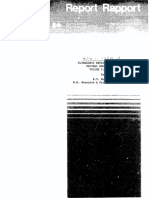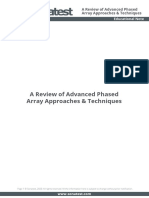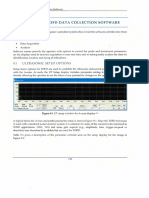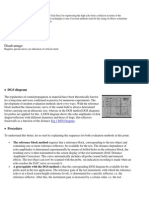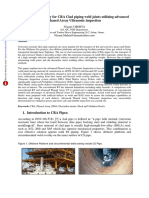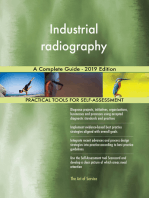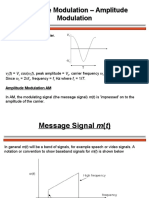X3 Training Program - The Basics of TFM
X3 Training Program - The Basics of TFM
Uploaded by
Thiru RajaCopyright:
Available Formats
X3 Training Program - The Basics of TFM
X3 Training Program - The Basics of TFM
Uploaded by
Thiru RajaOriginal Title
Copyright
Available Formats
Share this document
Did you find this document useful?
Is this content inappropriate?
Copyright:
Available Formats
X3 Training Program - The Basics of TFM
X3 Training Program - The Basics of TFM
Uploaded by
Thiru RajaCopyright:
Available Formats
The Basics of FMC and TFM
Olympus Scientific Solutions
DSM Team | Quebec | April 2020
Agenda
1. FMC/TFM basics
2. Wave Sets (propagation modes)
3. Inspection setup in TFM
4. Advantages and limitations of TFM
5. Conclusion
Page 2 Olympus Corporation
1. FMC/TFM
• Full Matrix Capture and Total Focusing Method
FMC
▪ FMC: full matrix capture is a data acquisition process
▪ Pulse/receive sequence designed to obtain a large amount of waveform data from a single PA probe
▪ Data is collected by pulsing one element and receiving on all elements (process is repeated until each element is pulsed)
▪ Firing sequence creates A-scan data for every element set up to receive
Page 4 Olympus Corporation
FMC
▪ FMC: Transmitter sequence
Page 5 Olympus Corporation
FMC
▪ FMC: Receiver sequence
Page 6 Olympus Corporation
FMC
▪ This allows to collect all A-scans information for this transmitter/receiver combination and build what we call the matrix of
elementary A-scans thus, Full Matrix Capture name.
Page 7 Olympus Corporation
FMC
▪ The different amplitude of the signal is represented by colors, where the red is being the highest amplitude and the light blue
the lowest, just like Phased Array.
Page 8 Olympus Corporation
FMC
▪ The sequence is repeated until all the elements of the probe have emitted.
Page 9 Olympus Corporation
TFM
▪ TFM: total focusing method is a processing of the acquired data.
– TFM is an imaging technique and should be considered separate from the FMC process.
– TFM takes the waveform data from the FMC process and arranges the data in the image grid, or zone.
– The image constructed in the TFM zone is based on time of flight, element spacing, and the proper measurement mode.
▪ The user selects a reconstruction path called a wave set. The instrument then selects the right combinations of delays and
sums in the elementary A-Scans to provide the maximum focus at a given point in the grid.
Page 10 Olympus Corporation
TFM
▪ The data collected from each Transmitter Receiver combination is processed to create the “Focused everywhere” image.
Page 11 Olympus Corporation
TFM
▪ The data collected from each Transmitter Receiver combination is processed to create the “Focused everywhere” image.
– The complete sequence can be seen on our website: https://www.olympus-ims.com/en/fmc-tfm-basic-principles/
Page 12 Olympus Corporation
2. Wave Sets
• LL, TT, TTT, TTL, etc.
TFM Modes
▪ TFM reconstruction using FMC elementary A-scans is based mainly on the time of flight calculated according to the
inspection mode (pulse echo or self tandem) and the selected wave type: longitudinal, transverse or a combination of both.
▪ Pulse-echo mode (TT, LL, TTTT) is like standard PAUT, part geometry variations could affect the precision of the provided
position of detected indications.
▪ Self-tandem mode (TTT, TTL, LLL, LTL, TTTTT, etc.) yields additional scan sets compared to standard PAUT.
– However, results are very sensitive to geometry variations.
Page 14 Olympus Corporation
Most Common Wave Sets
Page 15 Olympus Corporation
3. Inspection Setup in TFM
• WaveSet and Probe selection, Amplitude Fidelity, Envelope
Standard PAUT: Scan Plan Setup
▪ The steps of creating an inspection setup with Phased Array go as follow:
– Part and/or weld definition
– Probe selection
– Wave mode selection: shear or longitudinal
– Scan type selection: sectorial, linear, or compound
– Scan parameters: focal laws, angular range and resolution, index offset, focus, etc.
Page 17 Olympus Corporation
TFM: Scan Plan | Modeling Setup
▪ With TFM, the steps are quite similar yet, different essential variables are added:
– Part and/or weld definition
– Probe selection
– Zone setting
– Wave set selection: TT, TTT, TTTT, LL, LLL, etc.
– Flaw definition: planar or spherical, expected angle
– AIM and sensitivity index evaluation
– Amplitude fidelity verification
Page 18 Olympus Corporation
Modeling with TFM
▪ Why modeling is crucial:
– Proper wave sets are critical for detection.
– Many wave sets are available (commonly 9+).
– The type of flaw influences wave set selection.
– The orientation of flaws also has an impact on wave set selection.
– The position (depth) of the flaw in the part also impacts the wave set you choose.
– Part geometry (curvature) will change the results.
– Focus is expected everywhere in the TFM zone as long as it is defined inside the Near Field.
• To confirm proper probes, frequencies, etc.
Page 19 Olympus Corporation
TFM Zone
▪ The TFM zone is the area of the part that the technician chooses to view as images.
– In PAUT, it is typically defined by the Ultrasound axis Start and Range as well as the Angle range.
▪ This is adjusted by the technician and can be moved anywhere within the part’s volume.
▪ Images are constructed in the zone grid using the preselected wave set and the time of flight of the FMC data.
Page 20 Olympus Corporation
Wave Set Selection
▪ Flaw detection and characterization capabilities are dependent on the selected wave set.
▪ As an example, here is the detection of a root crack using 2 different wave sets.
– With Pulse-Echo TT, we detect the corner trap and the tip diffraction similar to PAUT.
– With Self-Tandem TTT, the representation of the crack is best.
Page 21 Olympus Corporation
Wave Set Selection
▪ Flaw detection and characterization capabilities are dependent on the selected wave set.
▪ However, when changing the type of flaw and its location, the TTT wave set completely misses it.
Page 22 Olympus Corporation
AIM Simulation Tool
▪ AIM: Acoustic Influence Map
– Olympus’ AIM simulation tool helps the user to select the proper mode for the inspection and understand the effects for a
given flaw.
– AIM is a semi-analytical model that predicts and maps the amplitude sensitivity for TFM inspection.
– Accounts for probe frequency, element directivity, transmission/reflection coefficients, geometric beam spread, material
attenuation, and the directionality of the flaw.
• Displays the expected ultrasonic response for a given
wave set and reflector.
• Assists in optimal wave set selection.
• Gives a sensitivity index value
Page 23 Olympus Corporation
Multi Groups
▪ Some applications require more than a unique TFM wave set to ensure the proper detection of all flaws.
▪ It is possible to configure and run an inspection using up to 4 simultaneous groups.
Page 24 Olympus Corporation
Amplitude Fidelity
▪ Definition: Amplitude fidelity (AF) is the measurement (in dB) of the maximum amplitude variation of an indication caused by
the TFM grid resolution.
▪ Parameters that have influence on the value:
– Probe frequency and bandwidth
– Material velocity
– Grid resolution
– TFM Envelope
– Etc.
▪ ASME Code compliance for weld inspection: AF should not exceed 2 dB.
– Mandatory Appendix XI Full Matrix Capture (FMC) and Nonmandatory Appendix F Examination of Welds Using Full
Matrix Capture (FMC) – ASME BPVC Sec. V, Article 4. 2019
▪ If the Amplitude Fidelity is above 2 dB, the user can either reduce the zone size, increase the resolution, or increase the
probe frequency until the requirement is met.
Page 25 Olympus Corporation
Amplitude Fidelity
▪ Here is an example of the effect on the Resolution of an indication with different Amplitude Fidelity.
AF = 0.3dB AF = 1.2dB AF = 5.2dB
Page 26 Olympus Corporation
TFM Envelope
▪ The TFM envelope is obtained by computing the norm of two different TFM images: one computed using the standard
acquired FMC and a second computed using the Hilbert transformed FMC.
– No information is lost.
– This is signal processing and not a smoothing filter.
Page 27 Olympus Corporation
TFM Envelope
▪ Advantages of the TFM Envelope:
– Improved basis for amplitude-based sizing methods.
– Higher acquisition rate for equivalent Amplitude Fidelity value.
– Improved Signal-to-Noise ratio.
Envelope OFF Envelope ON
Page 28 Olympus Corporation
TFM Envelope
▪ Advantages of the TFM Envelope:
– Improved basis for amplitude-based sizing methods.
– Higher acquisition rate for equivalent Amplitude Fidelity value.
– Improved Signal-to-Noise ratio.
Resolution: 0.08mm Resolution: 0.17mm
Amplitude Fidelity: 1.9dB Amplitude Fidelity: 2.0dB
PRF: 12.4Hz PRF: 25.0Hz
Envelope OFF Envelope ON
Page 29 Olympus Corporation
4. Advantages and Limitations
• What to keep in mind when using TFM
Advantages
▪ Indication resolution.
– Ability to resolve closely spaced reflectors.
▪ With PAUT:
– If unfocused beams are used then the resolution of PAUT can be poor, the primary objective being the detection of
discontinuities rather than sizing.
– If focusing is used then good resolution can be achieved but it is limited to the area of focusing.
▪ With TFM:
– Image optimal resolution is achieved at all points within a well defined zone.
– Point reflectors in the region of interest, when spaced apart larger than the grid resolution, will image well and can be
resolved.
– Improving also the ability to characterize the nature of the reflectors.
Page 31 Olympus Corporation
Advantages
▪ Indication resolution.
– Ability to resolve closely spaced reflectors.
5L32-A32 contact
PAUT Linear Scan TFM LL Scan
Page 32 Olympus Corporation
Advantages
▪ Indication resolution.
– Ability to resolve closely spaced reflectors.
5L32-A32 contact
PAUT Linear Scan TFM LL Scan
Page 33 Olympus Corporation
Advantages
▪ Near-Surface resolution
– Detection of flaws close to the scanning surface and improved capability to inspect components of smaller thickness.
▪ With PAUT:
– Generally large dead zones with pulse-echo.
– We use beams where the receive direction is identical to the transmit direction.
– The beam is formed of multiple elements, it is called a wave front.
▪ With TFM:
– Detection of flaws close to the scanning surface and improved capability to inspect components of smaller thickness.
– Multiple transmit-receive paths between elements of the aperture spread over a much larger area of the front wall leads
to smaller dead zones in the image.
– Only 1 element is pulsed at a time.
Page 34 Olympus Corporation
Advantages
▪ Near-Surface resolution
– Detection of flaws close to the scanning surface and improved capability to inspect components of smaller thickness.
5L32-A32 contact
PAUT Linear Scan TFM LL Scan
Page 35 Olympus Corporation
Advantages
▪ Indication orientation accuracy
– With right wave set, the representation and orientation of the defect can be imaged accurately.
5L32-A32 with 55SW wedge
PAUT Sectorial scan plan TFM TTT scan plan
Page 36 Olympus Corporation
Advantages
▪ Indication orientation accuracy
– With right wave set, the representation and orientation of the defect can be imaged accurately.
5L32-A32 with 55SW wedge
PAUT Sectorial Scan TFM TTT Scan
Page 37 Olympus Corporation
Limitations
▪ Part Geometry
– Self-tandem mode results are very sensitive to a part’s thickness and geometry. An error in the time of flight calculation
may lead to poor detection capabilities or no detection at all.
▪ Thickness or Geometry changes will affect the accuracy of the readings when skipping the ultrasound.
– An accuracy error in the thickness input results in inaccurate readings.
– The computation of the time of flight relies heavily on the first and/or second bounces. If the TOF is shorter then expected
(material being thinner than the entered parameter), the indication can be entirely missed.
▪ Care should be taken when examining welds of complex geometry like weld joining materials of unequal thickness, materials
that are joined at an angle, nozzles, etc.
– This is also true for Pulse-Echo Wave Sets.
Page 38 Olympus Corporation
Limitations
▪ Part Geometry
– Self-tandem mode results are very sensitive to a part’s thickness and geometry. An error in the time of flight calculation
may lead to poor detection capabilities or no detection at all.
▪ Velocity input: 2.5% difference (80m/s) in value in TTT resulted in a loss in signal of 17.9 dB for this vertical notch.
Accurate Velocity 80m/s Velocity difference
Page 39 Olympus Corporation
Summary
▪ FMC/TFM technique provides additional inspection solutions when set properly.
▪ Probe selection is important for accurate results (Near Field).
▪ TFM procedures should be based on modeling and wave set validations.
▪ Orientation, location (depth), and type of flaw impact the results.
▪ Each inspection application requires a dedicated TFM technique/procedure that includes a detailed scan plan.
Page 40 Olympus Corporation
You might also like
- Ultrasonic Time of Flight Diffraction 1st Edition - SampleDocument19 pagesUltrasonic Time of Flight Diffraction 1st Edition - SampleSooraj Rajan67% (3)
- UT of TKY Connections PDFDocument14 pagesUT of TKY Connections PDFreiazh0% (1)
- Omniscan Techniques For Crack SizingDocument31 pagesOmniscan Techniques For Crack Sizingalinor_tnNo ratings yet
- Teletest WaveScan Software Introduction PDFDocument33 pagesTeletest WaveScan Software Introduction PDFThiru RajaNo ratings yet
- Handscan Manual Rev 2.0Document19 pagesHandscan Manual Rev 2.0Thiru RajaNo ratings yet
- Questions & Answers - Time of Flight Diffraction Technique (TOFD)Document5 pagesQuestions & Answers - Time of Flight Diffraction Technique (TOFD)aspoiaspoiNo ratings yet
- Cobra Scan InspectionDocument58 pagesCobra Scan InspectionMohsin Iam100% (2)
- TOFD L2 Exam Paper P2 Issue 1Document5 pagesTOFD L2 Exam Paper P2 Issue 1phutd0967% (3)
- DUAL MATRIX ARRAY OverviewDocument37 pagesDUAL MATRIX ARRAY OverviewLe Anh Duy100% (1)
- Acceptable Criteria API RP 2X Level C Acceptable Criteria API RP 2X Level CDocument1 pageAcceptable Criteria API RP 2X Level C Acceptable Criteria API RP 2X Level CRamakrishnan AmbiSubbiah100% (5)
- OmniSX - MX2 - Training - 16J TOFD Flaw Sizing and CharacterizationDocument35 pagesOmniSX - MX2 - Training - 16J TOFD Flaw Sizing and Characterizationaldeanucu100% (3)
- PAUT Assessment Book Rev 2 June 2017Document58 pagesPAUT Assessment Book Rev 2 June 2017Scribd Scribd100% (5)
- Phased Array Calculations With AnswersDocument8 pagesPhased Array Calculations With AnswersLương Hồ Vũ100% (1)
- NDT SetupBuilder - OverviewDocument32 pagesNDT SetupBuilder - OverviewgueridiNo ratings yet
- C1 2Document38 pagesC1 2Lương Hồ Vũ100% (1)
- S-UG-5003 Teletest Focus+ User Guide Rev 0.2Document44 pagesS-UG-5003 Teletest Focus+ User Guide Rev 0.2Thiru RajaNo ratings yet
- FY32xxS Series User's Manual V1.4Document15 pagesFY32xxS Series User's Manual V1.4ttwigg83100% (1)
- Codes TFM Webinar-DSDocument96 pagesCodes TFM Webinar-DSThành TrịnhNo ratings yet
- 8c 3 Dao Caulder AOS TPAC Next Generation Phased Array UT Total Focusing MethodDocument52 pages8c 3 Dao Caulder AOS TPAC Next Generation Phased Array UT Total Focusing Methodmkjbkm,sbkjm,nNo ratings yet
- Full Matrix Capture and Total Focusing MethodDocument7 pagesFull Matrix Capture and Total Focusing MethodMuhammad UmairNo ratings yet
- MX2 Training Program 13 Multiprobe InspectionDocument8 pagesMX2 Training Program 13 Multiprobe InspectionVictor Antonio Diaz FaundezNo ratings yet
- PAUT Procedure EEISDocument13 pagesPAUT Procedure EEISZakirUllahNo ratings yet
- 1.2 TOFD Digitization Principles 2010Document35 pages1.2 TOFD Digitization Principles 2010Hoang Diep PhanNo ratings yet
- TOFD Time of Flight DiffractionDocument4 pagesTOFD Time of Flight DiffractionJeff Adams100% (2)
- 2011 PipeWizard Training Part 01Document62 pages2011 PipeWizard Training Part 01rajeev jegadeesan100% (1)
- 20dB DropDocument84 pages20dB Dropphan hoang diepNo ratings yet
- Beamtool Scan Plan Inspection Layout: 25Mm 200Mm 100Mm 0Mm Steel 1020 3.24Mm/Μs 5.89Mm/ΜsDocument3 pagesBeamtool Scan Plan Inspection Layout: 25Mm 200Mm 100Mm 0Mm Steel 1020 3.24Mm/Μs 5.89Mm/Μsநந்த குமார் சம்பத் நாகராஜன்No ratings yet
- Tofd Development: TechniqueDocument32 pagesTofd Development: TechniqueLương Hồ VũNo ratings yet
- A Review of Advanced Phased Array Approaches TechniquesDocument17 pagesA Review of Advanced Phased Array Approaches Techniquesbhargav121100% (1)
- 2.a.omniscan Setup - Calibration For Sectorial ScanDocument34 pages2.a.omniscan Setup - Calibration For Sectorial Scancarlos0% (1)
- CW3Document5 pagesCW3phutd09No ratings yet
- Collection: SoftwareDocument64 pagesCollection: SoftwareLương Hồ VũNo ratings yet
- DGS DiagramDocument3 pagesDGS DiagramDhanasekaran R100% (1)
- Characterization of Small Defects Using Total Focusing MethodDocument6 pagesCharacterization of Small Defects Using Total Focusing MethodMohsin IamNo ratings yet
- PCN - C4 - TofdDocument8 pagesPCN - C4 - TofdKaruppusamy NallappagounderNo ratings yet
- PAUT Solution For Flange-Pipe WeldDocument25 pagesPAUT Solution For Flange-Pipe WeldAbderrahmane79No ratings yet
- PA Caracterization BlockDocument2 pagesPA Caracterization BlockMuallim MursyidNo ratings yet
- Advances in Phased Array Weld Inspection Scan Plan DesignsDocument18 pagesAdvances in Phased Array Weld Inspection Scan Plan Designshcmcrlho100% (1)
- Phased Array UT Versus RT Report TruncatedDocument20 pagesPhased Array UT Versus RT Report TruncatedSungsoo HanNo ratings yet
- Transfer CorrectionDocument1 pageTransfer CorrectionkattabommanNo ratings yet
- Code Case 181-2 Section 7 & 8 Flaw Evaluation Worksheet (Short)Document81 pagesCode Case 181-2 Section 7 & 8 Flaw Evaluation Worksheet (Short)庄查理100% (1)
- 01-Introduction To OMNIDocument19 pages01-Introduction To OMNIvibinkumars100% (1)
- Olympus TFM FMCDocument51 pagesOlympus TFM FMCHermann LeonardoNo ratings yet
- What Are Phased Arrays?: Modify Electronically Probe Characteristics Introducing Time Shifts Individual ElementsDocument68 pagesWhat Are Phased Arrays?: Modify Electronically Probe Characteristics Introducing Time Shifts Individual ElementsLương Hồ VũNo ratings yet
- API UT21 ThicknessProcedure 20190304Document7 pagesAPI UT21 ThicknessProcedure 20190304michael100% (1)
- Omniscan Mx2 Training Program: Introduction To Phased Array Using The Omniscan Mx2Document38 pagesOmniscan Mx2 Training Program: Introduction To Phased Array Using The Omniscan Mx2hcmcrlhoNo ratings yet
- Asme Sec 5 TofdDocument6 pagesAsme Sec 5 TofdarsalanhaqNo ratings yet
- Selection of Test Parameters: Ashley JolleyDocument19 pagesSelection of Test Parameters: Ashley JolleyAsish desaiNo ratings yet
- Phased Array Ultrasonic Testing of Welds - 141-160Document20 pagesPhased Array Ultrasonic Testing of Welds - 141-160Kevin HuangNo ratings yet
- Advances in Tube Testing 2008Document39 pagesAdvances in Tube Testing 2008AhmedA.Hassan100% (1)
- PAUT ProcedureDocument15 pagesPAUT ProcedureBIPLPRAVIN BOSENo ratings yet
- UT - The Practical Guide To Ultrasonic Testing in The Real World PDFDocument9 pagesUT - The Practical Guide To Ultrasonic Testing in The Real World PDFjar_20% (1)
- Eddyfi CorporatePresentation Feb2015Document37 pagesEddyfi CorporatePresentation Feb2015Anonymous CD0suI9No ratings yet
- LRPDF-Applus RTD Catalogus Probe DepartmentDocument28 pagesLRPDF-Applus RTD Catalogus Probe DepartmentDhanasekaran RNo ratings yet
- TOFD by TempleDocument444 pagesTOFD by TempleAlejandro Mejia RodriguezNo ratings yet
- Paut RequormentDocument12 pagesPaut RequormentGolden Lotus100% (2)
- Ultrasonic Matrix ArrayDocument10 pagesUltrasonic Matrix ArrayMohsin IamNo ratings yet
- Non-Destructive Evaluation of Corrosion and Corrosion-assisted CrackingFrom EverandNon-Destructive Evaluation of Corrosion and Corrosion-assisted CrackingRaman SinghNo ratings yet
- TFM Imaging For NDT: Phased-Array TechnologiesDocument26 pagesTFM Imaging For NDT: Phased-Array TechnologiesMoll22100% (1)
- Overview of FMC and TFMDocument19 pagesOverview of FMC and TFMMuhammad Umair100% (1)
- Sonatest FMC TFMDocument23 pagesSonatest FMC TFMPetr100% (1)
- Report No: MSE/JEL/EXM/CRISP/PMI/F/001Document20 pagesReport No: MSE/JEL/EXM/CRISP/PMI/F/001Thiru RajaNo ratings yet
- Visual Weld InspectionDocument53 pagesVisual Weld InspectionThiru RajaNo ratings yet
- UG Teletest PDFDocument44 pagesUG Teletest PDFThiru RajaNo ratings yet
- Technical Brief Sphere Leg Inspection PDFDocument1 pageTechnical Brief Sphere Leg Inspection PDFThiru RajaNo ratings yet
- Olympus Multiscan MS 5800 Tube Inspection System PDFDocument8 pagesOlympus Multiscan MS 5800 Tube Inspection System PDFThiru RajaNo ratings yet
- 0027 PDFDocument1 page0027 PDFThiru RajaNo ratings yet
- UT PCN NotesDocument113 pagesUT PCN NotesThiru Raja95% (20)
- Operating Manual MHS-5200A Series Dual-Channel DDS Signal GeneratorDocument20 pagesOperating Manual MHS-5200A Series Dual-Channel DDS Signal Generatorsempreaprender3701No ratings yet
- Compositionalmodels XenakisDocument44 pagesCompositionalmodels XenakisVicente Barba VarelaNo ratings yet
- 11 Alternating Current (AC) PDFDocument13 pages11 Alternating Current (AC) PDFRidho KurniaNo ratings yet
- Ansi/I - TR75.04.01 - 8: Control Valve Position StabilityDocument20 pagesAnsi/I - TR75.04.01 - 8: Control Valve Position StabilityYatã SantojaNo ratings yet
- LabVIEW PDFDocument2 pagesLabVIEW PDFRameshkumar JayaramanNo ratings yet
- Eet-216 Lab #7 v1.2fl - Wind TurbineDocument19 pagesEet-216 Lab #7 v1.2fl - Wind Turbinekugarajravi2002No ratings yet
- Characterizing Transformer HV-LV Winding FRA Curves Through Derivation of Transfer Functions From FRA DataDocument11 pagesCharacterizing Transformer HV-LV Winding FRA Curves Through Derivation of Transfer Functions From FRA DataZhi ZhangNo ratings yet
- Lab Manual: Digital Electronics Lab (EC 214 B) : Experiment No: 01Document24 pagesLab Manual: Digital Electronics Lab (EC 214 B) : Experiment No: 01Anonymous lercF1p2pNo ratings yet
- Amplitude ModulationDocument70 pagesAmplitude Modulationhamkane100% (1)
- Science: Waves: Carriers of EnergyDocument30 pagesScience: Waves: Carriers of EnergyMelanie Tagudin Trinidad100% (5)
- Analysis and Comparision of Peak To Peak Current Ripple in 2 Level &multi Level InvertersDocument10 pagesAnalysis and Comparision of Peak To Peak Current Ripple in 2 Level &multi Level InvertersAdari G V Chiranjeevi ACOENo ratings yet
- Physio of PhonationDocument71 pagesPhysio of PhonationRamya CherukuriNo ratings yet
- Wave MotionDocument17 pagesWave MotionMichael Anthony Ballon DenuboNo ratings yet
- Cie A2 Physics 9702 Practical v3Document5 pagesCie A2 Physics 9702 Practical v3Fasih AhmadNo ratings yet
- MicroMag Vibrating Sample Magnetometer (μ μ VSM)Document10 pagesMicroMag Vibrating Sample Magnetometer (μ μ VSM)James YoungNo ratings yet
- 920-654F Druck DPI620G Datasheet - ENDocument19 pages920-654F Druck DPI620G Datasheet - ENanasNo ratings yet
- 5e's Lesson Plan in Science 7Document10 pages5e's Lesson Plan in Science 7ROSEL SARIEGONo ratings yet
- PCS130 SimpleHarmonic 0Document7 pagesPCS130 SimpleHarmonic 0Ekan AhmadNo ratings yet
- Physics - Practice Test (Jee Mains) - 14.10.24Document6 pagesPhysics - Practice Test (Jee Mains) - 14.10.24PHYSICS LSNo ratings yet
- DSP SamplingDocument36 pagesDSP Samplingin_visible100% (1)
- Department of Electrical Engineering Analogue and Digital CommunicationDocument11 pagesDepartment of Electrical Engineering Analogue and Digital CommunicationZubair KhalidNo ratings yet
- Cxa 7000r - SonyDocument23 pagesCxa 7000r - SonyStevenNo ratings yet
- Power & Grounding Basics: EMERSON Process Management - Educational ServicesDocument20 pagesPower & Grounding Basics: EMERSON Process Management - Educational Servicesrogelio surco100% (1)
- PasqualeUT 16 4 99newDocument5 pagesPasqualeUT 16 4 99newbenergy84No ratings yet
- A Review of Hazards Associated With Exposure To Low VoltagesDocument18 pagesA Review of Hazards Associated With Exposure To Low VoltagesthumbkissNo ratings yet
- Audio Video Systems (2151101) : Laboratory Manual (AY 2019-20)Document18 pagesAudio Video Systems (2151101) : Laboratory Manual (AY 2019-20)kamlesh chauhanNo ratings yet
- Phonetics As A Branch of Linguistics PDFDocument51 pagesPhonetics As A Branch of Linguistics PDFAlina KachurNo ratings yet
- ECE230Document3 pagesECE230KRISHNAPRIYANo ratings yet
- Type Test NotesDocument51 pagesType Test NotesNeelakandan MasilamaniNo ratings yet

























